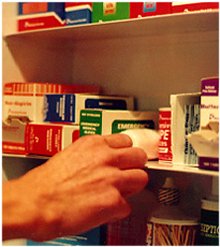15 April 2005
More Dirt On Antimicrobial Soaps
by Kate Melville
 Virginia Tech researchers have found that the use of antimicrobial soaps and other cleaning products may be directly exposing consumers to significant quantities of the carcinogen chloroform. Researcher Peter Vikesland has shown that when the chemical triclosan, present in many antimicrobial soaps, reacts with chlorine in tap water, chloroform is produced. Triclosan is a synthetic antimicrobial agent. Its broad-spectrum bacteria-fighting ability has made it increasingly pervasive in personal care products, cosmetics, antimicrobial creams, acne treatments, lotions, hand soaps, and dish soaps.
Virginia Tech researchers have found that the use of antimicrobial soaps and other cleaning products may be directly exposing consumers to significant quantities of the carcinogen chloroform. Researcher Peter Vikesland has shown that when the chemical triclosan, present in many antimicrobial soaps, reacts with chlorine in tap water, chloroform is produced. Triclosan is a synthetic antimicrobial agent. Its broad-spectrum bacteria-fighting ability has made it increasingly pervasive in personal care products, cosmetics, antimicrobial creams, acne treatments, lotions, hand soaps, and dish soaps.
"This is the first work that we know of that suggests that consumer products, such as antimicrobial soap, can produce significant quantities of chloroform," said Vikesland. "There are numerous potential exposure pathways that can be envisioned, such as inhalation and skin exposure, when using antimicrobial soaps to wash dishes or when taking a shower. There is also risk of exposure when using triclosan laden moisturizers as they may also react with chlorine in the water."
Vikesland and his associates conducted their research to closely mimic conditions found when washing dishes in the home. The results show that it is possible that the chloroform produced when the antimicrobial soap containing triclosan mixes with chlorinated water could be absorbed through your skin or inhaled.
These new findings add weight to calls for the FDA to closely monitor and possibly regulate the home use of antimicrobials such as triclosan. Most of the consumer products that contain triclosan eventually end up being discharged down residential drains. Previous research has shown that photochemical reactions involving triclosan could be producing dioxins in the presence of sunlight. Researchers are concerned as even at low levels, dioxins tend to accumulate along the food chain. The researchers note that the increasing popularity of antimicrobial products has preceded the study of the possible harmful affects of the use of such products.
